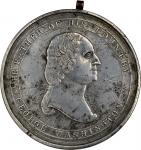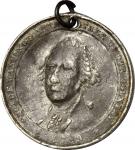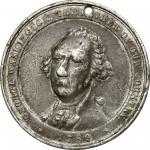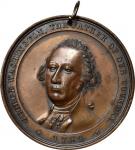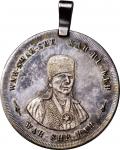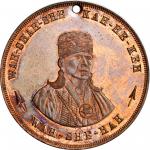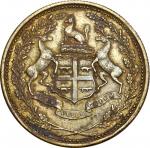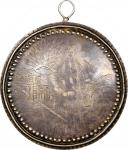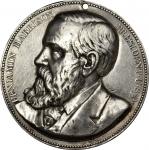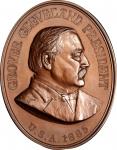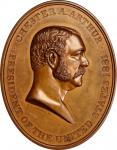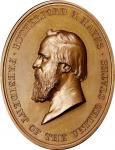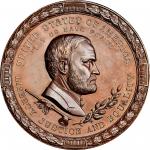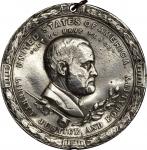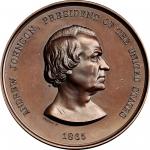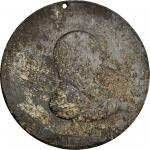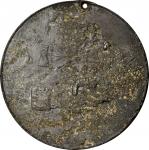Circa 1843 Pierre Chouteau, Jr. & Co. Upper Missouri Outfit Fur Trade Medal. Pewter (tested as 98.397% tin, 1.056% antimony, 0.547% lead). Prucha-62, var. Fine, or so. 88.6 mm. 2367.4 grains. Pierced for suspension with obvious wear in the hole and slight outward distortion of the thin edge above. Fairly rough in places, though where the detail is present it is reasonably sharp. The surfaces are uniformly oxidized to gently granular slate gray, with extensive areas of deeper pitting that have earthen deposits. Ancient abrasions are seen on both sides, while a couple of deeper cuts are noted on the obverse. Wavy in places and with some small chips from the rims and edges.This piece is from dies that we have not seen described before. The basic legends are the same as the usual Chouteau medals, and the letter punches appear identical to those seen on the usual medals as well as those with the George Washington portrait. Since both were made by B. Mead, this is as expected. On the obverse, the upper legend is: * * * PIERRE CHOUTEAU Jr & Co. * * [illegible]. The "*" symbols are six-pointed rosettes, three at left and at least two at right. They are free standing, and quite unlike the leaf motifs on the usual Chouteau medals. Each rosette is designed with a central depression and a tiny raised bead in the middle. Rosettes of this exact style are seen on the 1843 Washington head medals. The legend below is only partial but reads: UPPER MISSO[…], with the remainder lost due to corrosion. The legends are close to the plain narrow rim, with an inner borderline of plain, tightly juxtaposed and roughly square dots. This is very similar to that inner border seen on the Washington obverse. Relative to the portrait, the legend is positioned similarly to that seen on the usual Chouteau, though the portrait is centered toward the right here.. On the reverse, the legend is as usual. PEACE is gently curved downward at the top, FRIENDSHIP is gently curved upward at the bottom, and both are positioned close to a thin plain rim. AND is slightly curved downward at the center, dividing the crossed tomahawk and pipe motif above from the clasped hands below. The left hand is cuffed with three buttons, as typical, while the right arm is very heavily oxidized but seems to be plain. There is no inner border to separate the legends from the central design and there does not appear to be a date on either side. We are aware of eight Chouteau medals for the Upper Missouri Outfit, and only three of them are from this die pair. The writer has a circa 1940s image of one example from these dies which is of similar quality but certainly a different medal. We do not know its present location. The third one is at the South Dakota Historical Society. All of the fur trade medals are great rarities, with the Astor medal long being considering the most desired. In actuality, all of these issues are so rare that their infrequent offerings tend to keep them off the proverbial radar of most collectors. They seem virtually legendary rather than pieces that can be acquired. The Ford Collection remarkably contained two of the Astor pieces and one of the 1843 Washington head medals but there was no Chouteau represented. The last Chouteau we handled was in our January 2003 sale, and was called "Fine," but was described as bent in places, oxidized, with spade marks on the obverse and scratched below the bust. It was a bit sharper than this one, but it was far from "nice." In that catalog it was stated that it was "the first we can remember handling." Those we know about are as follows:1. The Bauman Belden Plate, 1927. Whereabouts unknown.2. American Numismatic Society3. American Numismatic Society. The Prucha Plate Piece.4. Stacks, January 2003:15205. Crane Collection, Denver Museum of Nature and Science6. The present specimen.7. Imaged in the 1940s. Whereabouts unknown.8. South Dakota Historical SocietyGreat Peace medal collections like those of Andrew Zabriskie, W.H. Hunter, W.W.C. Wilson, Charles Senter, David W. Dreyfuss, Chris Schenkel and Charles Wharton did not have one. This example is being offered here for the first time in the context of a major sale, it having first appeared on eBay more than a decade ago where our consignor acquired it. As a new specimen of the prized Chouteau medal it is certainly exciting. As a previously undescribed die pairing that can so easily be punch-linked to both the usual Chouteaus and the Washington-head medals, it is a most remarkable offering, indeed, and a prize for anyone who appreciates these very historic pieces. Though no makers mark is visible on this piece (and it may simply have succumbed to the environment), this medal was certainly made by B. Mead, an engraver of St. Louis who has been virtually unknown beyond these fur trade medals. Who was "B. MEAD?"It would appear that our B. Mead was Benjamin Wicks Mead. The best supporting evidence is to be found in the Saturday, August 28, 1841 edition of the Daily Missouri Republican, where Mr. A.B. Chambers wrote in:I take the liberty of sending a medal, dedicated to the Native Americans of the U. States, by Benjamin Mead, a member of the Association of Missouri. I think you will, at least, award to the engraver, the merit of being a skillful [sic] artist, even if you cannot assent to all the principles with the Natives adhere to.</em>The editor responds:That we can do right heartily. The medal may be seen at this office. We learn upon inquiry, that it is the handiwork of an artist, on Oak street, to whose proficiency in the art it is altogether creditable.</em>Mead himself placed an advertisement in the Old School Democrat and Saint Louis Weekly Herald</em>, appearing Wednesday, April 13, 1842. Headed TEMPERANCE MEDALS, it read:The subscriber respectfully informs the public that he is prepared to supply appropriate Medals for the Washingtonian Temperance Society, in numbers sufficient to supply the demand. Having been at considerable expense in making the dies and preparing to make the impression, and being a member of the Society, and of this community, he hopes that his sales may save him from material loss. The medals may be had at the Bulletin Office, at the St. Louis Type Foundry, and at my residence on Morgan, between Seventh & Eighth streets.</em>A very liberal discount will be made to the Societies and those who buy to sell again. They will be for sale on the Secretarys table at the meetings of the Society.</em>While neither account points directly to the fur trade medals, here we have two entries in the historical record establishing Benjamin Mead as a die sinker in St. Louis. A city directory of 1852 places Benjamin W. Mead as a resident of the Virginia Hotel. A city directory of 1857 also lists a "Benj. W. Mead" in the city, residing at the Monroe House, which was located on a corner of Olive and Second Streets. Another mention of him local to St. Louis is in a published 1862 listing titled, A Complete List of Exempts in St. Louis Division, E.M.M</em>, containing the names of those men not required to enlist in the local Militia. The reason given for Mr. Meads exemption was his advanced age at the time.Further promising evidence as to Meads identity may be found in Pioneer Life in Dayton and Vicinity, 1796-1940</em>, by John Farris Edgar. Passages therein discuss Benjamin Wicks Mead, who had married Abigail Webb Thatcher Hall in Boston, in 1829, and moved to Dayton in 1829. It is unclear from this text as to what business he was engaged in while in Dayton, but one promising prospect was an engraving firm, Peasley & Mead. The principal, Aaron Merrill Peasley was from Boston, and a successful button maker who produced buttons for military use during the War of 1812. Peasley relocated to Dayton around 1826 or 1827 where he was recognized as a "skillful engraver and die-sinker." The connection of Peasley and our Mead are circumstantial only, but Edgars book further reports that Benjamin Wicks Mead was "very ingenious, and made a large clock, casting the parts in brass," illustrating a degree of skill with metal work. He commented that "Mead died in St. Louis in 1849," which does not align with the city directories we found of the 1850s, but it does place the Benjamin W. Mead of Boston and Dayton in St. Louis, and the death report could well be in error. Whatever the backstory of Mead, for the first time we have an identity for the mysterious engraver who produced the St. Louis fur trader medals. We do not know what medals Mead created in celebration of Native Americans in 1841, nor do we know what Temperance medals he offered for sale in 1842, raising two interesting research questions. It is not difficult to imagine that the commissions for the fur trade medals were prompted in part by the newspaper notices of Meads works in 1841 and 1842. The medals for Chouteau were struck circa 1843 for distribution among Native Americans active in the fur trade, and were almost certainly part of a broader scheme to solidify the Chouteau firms dominance. In fact, 1843 was a critical period for the firm and its trading establishment. Four years after the retirement of John Jacob Astor in 1834, the St. Louis-based firm was formally renamed for Pierre Chouteau, Jr., in 1838, though in common usage the name "American Fur Company" never fell out of favor. By 1842, there were at least six rival trading firms competing for American Fur territory. In an effort to cement their position and authority in the area, the Chouteau firm lobbied to re-establish the United States Indian Agent for the Upper Missouri, with the aim of stopping the illegal flow of alcohol into the territory, a trade good that was increasingly critical in currying favor with the native traders. Without this benefit, it was believed that the long-standing dominance of the American Fur Company would be more difficult to encroach upon. They succeeded in the renewal of the Agency, in 1843, and were able to get one of their own traders assigned to the office, allowing them to operate a bit more freely in their competition with other firms than they might have otherwise. By some accounts, this included a blind-eye turned to their own continued illegal distribution of alcohol.Chouteau looked to the past in reviving the tradition of distributing private medals that Astor had established in the early 1830s. As official medals were known and respected by the local native populations, these would be ideal candidates to potentially increase the Chouteau advantage. The undated Chouteau medals like this one were probably the first issued, in 1842 or 1843. Those dated 1843 were probably struck in early 1844, as something</em> prompted the addition of the date. This was probably a reaction to the March 1844 ban on such medals.One of Chouteaus leading competitors operated under the name, Union Fur Company, and was established in time for the 1842 trading season. It was under the aegis of Fox, Livingston & Company of New York. They also issued fur trade medals under their own name, dated 1844, styled virtually identical to the Chouteau medals, and produced by B. Mead in St. Louis. The stiff competition did not last long, however, as the Union Fur Company agents had miscalculated the dominance and advantages of the Chouteau firm. Union Fur was in operation only a short time, and was sold to the Chouteau enterprise in 1845. Their medals were an apparent desperate response to the Chouteau effort, were hopelessly short-lived and are the rarest today. Discovered in California and purchased by our consignor through an intermediary on eBay, October 2007.

